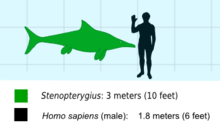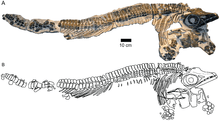Stenopterygius
| Stenopterygius Temporal range: Early Jurassic, 183–179 Ma | |
|---|---|
 | |
| Stenopterygius quadriscissus | |
| Scientific classification | |
| Kingdom: | Animalia |
| Phylum: | Chordata |
| Class: | Reptilia |
| Order: | †Ichthyosauria |
| Family: | †Stenopterygiidae |
| Genus: | †Stenopterygius Jaekel, 1904 |
| Species | |
| |
Stenopterygius is an extinct genus of thunnosaur ichthyosaur known from Europe (England, France, Germany, Luxembourg and Switzerland).[1][2] Maximum length was 4 meters (13 feet).[1][3][4]
Description

Stenopterygius was physically similar to the better known Ichthyosaurus, but had a smaller skull and narrower flippers. Beautifully preserved fossils of Stenopterygius have been found in Germany.[5] Its skull was extended into a kind of a beak and was armed with a quantity of large teeth. The limbs had been transformed to fin-like structures. The tail terminated in a large, semicircular, leathery, vertical caudal fin and even a triangular dorsal fin was present.
Palaeobiology
The habits of Stenopterygius were similar to those of present-day dolphins. It spent most of its life in the open sea, where it hunted fish, cephalopods and other animals. The abdominal cavity of skeletons of this ichthyosaur often contains the remains of such food.[6][7]
One famous fossil is that of a mother and baby that died in childbirth (ichthyosaurs were viviparous). This proved that ichthyosaur infants were born tail-first, just like cetaceans, to prevent them from drowning before fully clearing the birth canal.[8]
Stenopterygius was a very fast swimmer, with a cruising speed similar to that of tuna, which is among the fastest of all living fishes.
Classification

Most of the known specimens of Stenopterygius, more than 100, were recently redescribed by Michael W. Maisch. He found that S. quadriscissus (the type species) also includes S. eos, S. incessus and S. macrophasma, as well as specimens previously referred to S. hauffianus and S. megacephalus. Maisch followed Woodward (1932) and considered Ichthyosaurus triscissus to be a valid species of Stenopterygius. The type specimens of S. longifrons, S. megacephalus, and S. megalorhinus were all referred to this species as the name I. triscissus has a priority over them. Some specimens previously referred to S. megalorhinus, as well as the holotype of S. cuneiceps, were found to belong to a species of their own for which the binomen Stenopterygius uniter can be used. As the holotype of S. uniter was destroyed in World War II, Maisch proposed a neotype. Maisch also found that S. promegacephalus is a nomen dubium as it is based on juvenile specimen, and that the lectotype of S. hauffianus can be determined as Stenopterygius cf. S. quadriscissus at best, and therefore this species should be considered a nomen dubium. He found out that most specimens previously referred to S. hauffianus can be referred to S. quadriscissus, while the rest belongs to a highly distinctive new taxon that can't be referred to any valid species of Stenopterygius. This species was reassigned to its own genus, Hauffiopteryx.[2]
Stenopterygius is known from the lectotype GPIT 43/0219-1, articulated complete skeleton which preserved a very large embryo. The animal is about 3.15 m (10.3 ft) in length. It was collected from the Harpoceras elegantulum-exaratum ammonoid subzones (more specifically Lias ε II3-4), Harpoceras falcifer zone, of the famous Posidonien-Schiefer lagerstätte (Posidonia Shale) of Holzmaden, dating to the early Toarcian stage of the Early Jurassic, about 182 million years ago. Maisch referred to the type species 30 additional specimens, all came from Dobbertin of Mecklenburg-Vorpommern and Holzmaden, Germany and Dudelange, Luxembourg. They were collected from the Harpoceras palum to H. falciferum ammonoid subzones (Lias ε I2-II11, lower-middle early Toarcian), Harpoceras tenuicostatum-falcifer zones, of the Posidonia Shale. S. triscissus is known from the holotype GPIT 12/0224-2, articulated almost complete skeleton. The animal is a young adult about 2.1 m (6.9 ft) in length. It was collected from the Harpoceras exaratum-elegans ammonoid subzones (more specifically Lias ε II6), Harpoceras falcifer zone, of the Posidonia Shale, in Ohmden, dating to the middle Early Toarcian stage of the Early Jurassic. Maisch referred to this species 13 additional specimens, all came from various localities in England, France, Germany, Luxembourg and Switzerland. They were collected from the Lias ε II1-III, dating to the middle-late Early Toarcian. S. uniter is known from the holotype SMNS 14216, articulated complete skeleton which was destroyed in World War II. The animal is an adult about 3.35 m (11.0 ft) in length. The proposed neotype is GPIT 1491/10, articulated almost complete skeleton. The animal is a young adult about 2.34 m (7.7 ft) in length. It was collected from the Harpoceras falcifer ammonoid subzones (more specifically Lias ε II10), Harpoceras falcifer zone, of the Posidonia Shale, in Holzmaden, dating to the middle Early Toarcian stage of the Early Jurassic. Maisch referred to this species 10 additional specimens, all came from Holzmaden. They were collected from the Harpoceras exaratum to H. falciferum ammonoid subzones (Lias ε II6-II11, middle early Toarcian), Harpoceras falcifer zones, of the Posidonia Shale.[2]

Additional materials were described by Hannah Caine and Michael J. Benton in 2011, from the early Toarcian of Strawberry Bank, Ilminster of England. The specimens are all juveniles or infants which preserved mostly by almost complete skeletons and some skulls. They include BRLSI M1405, BRLSI M1407, BRLSI M1408, BRLSI M1409. Caine and Benton referred these specimens to S. triscissus.[9]
A new Middle Jurassic species from Southwestern Germany, Stenopterygius aaleniensis, was described in 2012.[10]
Maisch and Matzke (2000) and Maisch (2010) regarded Chacaicosaurus and Hauffiopteryx to be stenopterygiids.[1][11] However, they didn't performed any cladistic analyses to confirm these claims. Fischer et al. (2011) performed a cladistic analysis that found Chacaicosaurus to be a basal thunnosaur which is placed outside both Stenopterygiidae and Ophthalmosauridae.[12] Both Maisch (2008) and Caine and Benton (2011) performed cladistic analyses that found Hauffiopteryx to be either a basalmost member of Eurhinosauria or a basalmost member of Thunnosauria (which is an equivalent position to a basalmost member of Stenopterygiidae sensu Maisch [2008] with exclusion of Ichthyosaurus).[2][9] These results mean that Stenopterygiidae is a monotypic family which include only the type genus Stenopterygius.[12]

_(19777856284).jpg)
The cladogram below follows the topology from a 2010 analysis by Patrick S. Druckenmiller and Erin E. Maxwell.[13]
| Thunnosauria |
| ||||||||||||||||||||||||||||||||||||||||||||||||||||||||||||||||||||||||
| |
Etymology
Stenopterygius was originally named by Quenstedt in 1856 as a species of Ichthyosaurus, I. quadriscissus. Otto Jaekel in 1904 reassigned it to its own genus, Stenopterygius. The type species is therefore Stenopterygius quadriscissus.[2] The generic name is derived from stenos, Greek for "narrow", and pteryx (πτερυξ), Greek for "fin" or "wing".[4]
See also
References
- 1 2 3 Michael W. Maisch and Andreas T. Matzke (2000). "The Ichthyosauria" (PDF). Stuttgarter Beiträge zur Naturkunde: Serie B. 298: 1–159.
- 1 2 3 4 5 Michael W. Maisch (2008). "Revision der Gattung Stenopterygius Jaekel, 1904 emend. von Huene, 1922 (Reptilia: Ichthyosauria) aus dem unteren Jura Westeuropas" (PDF). Palaeodiversity. 1: 227–271.
- ↑ Huene F. von 1939. Ein ganzes Ichthyosaurier-Skelett aus den westschweizerischen Voralpen. Mitteilungen der Naturforschenden Gesellschaft in Bern 1939, pp.: 1-14
- 1 2 McGowan C, Motani R. 2003. Ichthyopterygia. – In: Sues, H.-D. (ed.): Handbook of Paleoherpetology, Part 8, Verlag Dr. Friedrich Pfeil, 175 pp., 101 figs., 19 plts; München
- ↑ Martill D.M. (1993). "Soupy Substrates: A Medium for the Exceptional Preservation of Ichthyosaurs of the Posidonia Shale (Lower Jurassic) of Germany". Kaupia. 2: 77–97.
- ↑ Böttcher R (1989). "Über die Nahrung eines Leptopterygius (Ichthyosauria, Reptilia) aus dem süddeutschen Posidonienschiefer (Unterer Jura) mit Bemerkungen über den Magen der Ichthyosaurier". Stuttgarter Beiträge zur Naturkunde Serie B (Geologie und Paläontologie). 155: 1–19.
- ↑ Bürgin T (2000). "Euthynotus cf. incognitus (Actinopterygii, Pachycormidae) als Mageninhalt eines Fischsauriers aus dem Posidonienschiefer Süddeutschlands (Unterer Jura, Lias epsilon)". Eclogae geologicae Helvetiae. 93: 491–496.
- ↑ Böttcher R (1990). "Neue Erkenntnisse über die Fortpflanzungsbiologie der Ichthyosaurier". Stuttgarter Beiträge zur Naturkunde Serie B (Geologie und Paläontologie). 164: 1–51.
- 1 2 Hannah Caine and Michael J. Benton (2011). "Ichthyosauria from the Upper Lias of Strawberry Bank, England". Palaeontology. 54 (5): 1069–1093. doi:10.1111/j.1475-4983.2011.01093.x.
- ↑ Maxwell, E. E.; Fernández, M. S.; Schoch, R. R. (2012). Farke, Andrew A, ed. "First Diagnostic Marine Reptile Remains from the Aalenian (Middle Jurassic): A New Ichthyosaur from Southwestern Germany". PLoS ONE. 7 (8): e41692. doi:10.1371/journal.pone.0041692. PMC 3411580
 . PMID 22870244.
. PMID 22870244. - ↑ Michael W. Maisch (2010). "Phylogeny, systematics, and origin of the Ichthyosauria – the state of the art" (PDF). Palaeodiversity. 3: 151–214.
- 1 2 Fischer, V.; Masure, E.; Arkhangelsky, M.S.; Godefroit, P. (2011). "A new Barremian (Early Cretaceous) ichthyosaur from western Russia". Journal of Vertebrate Paleontology. 31 (5): 1010–1025. doi:10.1080/02724634.2011.595464.
- ↑ Patrick S. Druckenmiller and Erin E. Maxwell (2010). "A new Lower Cretaceous (lower Albian) ichthyosaur genus from the Clearwater Formation, Alberta, Canada". Canadian Journal of Earth Sciences. 47 (8): 1037–1053. Bibcode:2010CaJES..47.1037D. doi:10.1139/E10-028.
- 1 2 Arkhangel’sky, M. S., 1998, On the Ichthyosaurian Genus Platypterygius: Palaeontological Journal, v. 32, n. 6, p. 611-615.
| Wikispecies has information related to: Stenopterygius |
| Wikimedia Commons has media related to Stenopterygius. |

